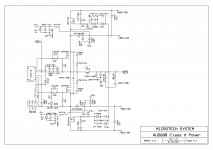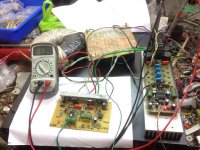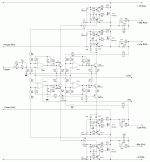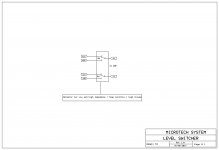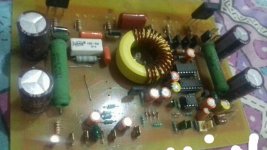Oh, I understand! You only needed a fancy word you also don't understand, but now you can put a label to the memory. Very professional!
The dynamic headroom is the result of the variable (dropping) power supply. Do you remember my 4th point?
"- power supply drop (dynamic one, not static!)"
You may or may not have more dynamic headroom with ClassD, it depends on the power supply! But this is not the only possible reason for loudness difference, and I'm too amateur to blindly accept the first and only answer when there are many possibilities.
The dynamic headroom is the result of the variable (dropping) power supply. Do you remember my 4th point?
"- power supply drop (dynamic one, not static!)"
You may or may not have more dynamic headroom with ClassD, it depends on the power supply! But this is not the only possible reason for loudness difference, and I'm too amateur to blindly accept the first and only answer when there are many possibilities.
Really thank you for your help. Pafi. Why complicate? Dynamic headroom is superior in class d because it has more efficacy than class b and less loss. It is so simple. Finally I am happy to understand. Thank you for wanting to help me. sorry for bothering
Why complicate?
Because it's simply not true.
Higher efficiency may increase static power (depending on overdrive characteristics), but it increases dynamic power less (theoretically none at all)! You measured less static power, it indicates that there is some limitation in that amplifier, and this limitation is not likely to magically disappear at dynamic peaks, so according to the informations you provided and also according to theory there are strong reasons to think dynamic headroom is not better.
But there are much more probable explanations.
D
Deleted member 148505
Hi,
Here is ckt (not full) class D with Class H power😀
Regards
MANOJ
hi sir manoj this is great news did it work .? can the voltage go up to
+/- 145 75 0 75 145 also can the impedance drop to 2ohms . ?? is this method of class h class d stable ?? also the noise in layout?? thanking you for your wonderfull designs sir manoj
Attachments
Hi,
This one was simple class H style. i din't check with 145v-75v supply,it will not handle 2 ohm load for continues application.
Regards
MANOJ
This one was simple class H style. i din't check with 145v-75v supply,it will not handle 2 ohm load for continues application.
Regards
MANOJ
Hi,
This one was simple class H style. i din't check with 145v-75v supply,it will not handle 2 ohm load for continues application.
Regards
MANOJ
2813wrms @2ohms
If psu is correct
Hahaha
2813wrms @2ohms
If psu is correct
Hahaha
if psu is correct +/- 75v,145v at halfbridge will be 5184watts


Hi,
pls tell me which ckt you asked (AUD1000SD or old 1000W)
regards
MANOJ
Hi Sir, Please pm part list for 1000w circuit.
pls tell me which ckt you asked (AUD1000SD or old 1000W)
regards
MANOJ
Hello Manojtm
greetings could you explain the advantage using CLASS H step
driver to a dclass amp i tried with QSC lm311 step MV70 V DC
HV 140 VDC
warm regards
Andrew😕
hi sir manoj any updates on this class dh amp??
Hi Andrew,
Advantage
1. stablity (when low to mid volume AMP running more time on lower supply rail only)
2. Low noise (when low to mid volume)
3. low Bus pump effect ( i think, not sure)
Regards
MANOJ
hi sir manoj . can i in-cooperate this 3 steps voltage of class h using n channel fets to drive a class d amp . voltage i intend to use is +/- 45,90,135 ??? 😕
Attachments
Hello. I wanted your help to understand. I did the test of my class amp d. I measure the temperature of the heatsink. Psu + -70v output amplifier loaded by resistive dummy load. 8ohm 56 ° after one hour. 4 ohm 85 ° after half an hour and protection cuts. The test is done with hard rock music at clipping. is it normal. Now I do not have the speaker that support this power to test in real load. Do the speaker require less power. Help me please to understand if this temperature is normal. With 6 ohm after one hour 65 °
Hi Stewin,
I think 3 stage class H is not give any advantage on class D.normally class d will run on high volt supply range,but the stability on low impedance is very poor on high supply range.I suggest +/-55V or +/-60v max. supply and you need more power use BTL mode
OR Use this
Regards
MANOJ
I think 3 stage class H is not give any advantage on class D.normally class d will run on high volt supply range,but the stability on low impedance is very poor on high supply range.I suggest +/-55V or +/-60v max. supply and you need more power use BTL mode
OR Use this
Regards
MANOJ
Attachments
Hi Stewin,
I think 3 stage class H is not give any advantage on class D.normally class d will run on high volt supply range,but the stability on low impedance is very poor on high supply range.I suggest +/-55V or +/-60v max. supply and you need more power use BTL mode
OR Use this
Regards
MANOJ
thank you sir manoj for the reply
Hi Stewin,
I think 3 stage class H is not give any advantage on class D.normally class d will run on high volt supply range,but the stability on low impedance is very poor on high supply range.I suggest +/-55V or +/-60v max. supply and you need more power use BTL mode
OR Use this
Regards
MANOJ
That is true. for low impedances you can put output stages in parallel. you can go up to 1 ohm. to be bridged in 2 ohm. many power
thank you sir manoj for the reply
you can have more than 100 amp with 10 pair of irf640n !!!!
provided that each pair is controlled by its own driver ir2110. the output of each pair is the common output. efficiency and power is what everyone is looking for. 😉
Hi,
My AUD1000SD i tested with VER2923-223 coil craft coil with DC +/-50v supply its give best sound quality fsw=435KHz(after @10 min it s reduced to 426KHz) MOSFET = IRFP250N; coil & mosfet cool
power out put is 220W @8R 410W @4R True RMS
Regards
MANOJ
Hello. Can I ask you to send me schematic and PCB for this project? If possible attach the file of the PCB in the format of the program,which was drawn printed circuit Board. My e mail alikangelok@mail.ru. With Respect to your creativity
- Home
- Amplifiers
- Class D
- My class D amp
